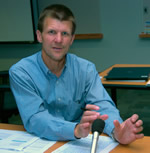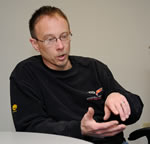Ruthless Pursuit of Power: The Mystique of the C6 Corvette LS7 Engine - Page 3 of 26
Ruthless Pursuit of Power: Lucky Seven Edition: The Mystique of the 7-Liter, 7000-RPM, LS7 - Page 3 of 26
 |
 |
by Hib Halverson
© May 2013— Updated: November 2014
No use without permission, All Rights Reserved
Meanwhile, in the Summer of 2002, over at GM Powertrain in Pontiac, where development of production hardware took place, the Small Block team, researching an LS6 successor, was experimenting with a 6.4-liter (390-cubic inch) V8 of about 450-hp. The 2005 Corvette was in development and they were looking at this "Six-Four" as what might power the next Z06, due a year later. During the design of the 6.4's cylinder head, Katech's C5-R engines were an influence. The most noticeable feature of this head was vastly different intake port location and geometry, compared with the "cathedral" intake port used in LS1, 2 and 6 heads. This different intake port architecture would have far-reaching effects on Small-Block V8s over the next dozen years.
John Rydzewski, currently Assistant Chief Engineer for Passenger Car Small-Block V8 Engines, said in a 2008 interview about that head, "A key enabler of this was moving the pushrod over. Now we had a bigger space, so we moved the port up, gave it a straight-on approach, made it larger, wider, with less turns and less bosses in the way of the flow path. The result is a huge improvement in performance."
Six-four development progressed into the Fall of 2002, but there was growing skepticism about displacement. Some were thinking that closer to seven-liters might be necessary. Elsewhere in GMPT, people were doing computer analysis of what it might take to reach the 500-horsepower level and that pointed at 7.0L, too.
Dave Muscaro, who, six months later, would be appointed as Assistant Chief Engineer Passenger Car V8s, told us about that period. "From a 6.4L vs 7.0L perspective, the goal of making 500 hp came sometime before I joined the program. I have a file showing analysis work to probe this power level was done at the end of October 2002. The analysis work was simply to see what airflow, friction, induction and exhaust restrictions, compression ratio, etc, etc, would be needed to create 500 hp. At that time, it was recognized that the engine displacement would likely need to go to 7.0L."
Winter of 2002/2003. Six-four development was well into the hardware stage. GM Vice Chairman for Global Product Development, Bob Lutz, along with senior Powertrain executives, then GM Powertrain Group Vice President, Tom Stephens, and then Small-Block Chief Engineer, Sam Winegarden, upset the apple cart by deciding the first number in the C6 Z's power rating must be a "5". While this decision is a well-known part of the LS7 story which added to its mystique, it would be ridiculous to assume that, one Friday after work, Bob, Tom and Sam, got together for beer and burgers then wrote "500-hp" on a bar napkin. More likely is that they reviewed some of the analysis data Muscaro cites, considered where their V8 engine technology was then and where they wanted Corvette to be power-wise in the next five years, then set 500 horses has a goal for their engineers.
Why?
"Competitive Pressure was part of it. The Viper was one of the competitors out there--probably the biggest--and there were others," John Rydzewski, who took over as ACE from Muscaro in May of 2005, told us in a second, 2012 interview.
Fourteen years ago, the most powerful Corvette engine, the LS6, made 405-hp but the Vette's underhood competition--most high-profile of which was the Dodge Viper's monster (but, also, inefficient) 488-cubic inch, 500-hp V10--was putting the Corvette's power rating to shame. There were others, too: Porsche Turbo-444-horses, Mercedes-Benz SL55 AMG-476-hp and Ferrari 575M Maranello-508-hp.
A 500-hp Corvette? Well...duh.
As Corvette Executive Chief Engineer, Tadge Juechter, who, during the C6 Z06 development, was Assistant Chief under David Hill, explained, "The LS7 is the pure-blood, track engine. When we were developing it, we knew it was going to be normally aspirated. For a while, that engine was going to displace 6.4-liters and the first horsepower target was 450. The base engine was 400. We thought: Oh man, more than 10%--that'd be a nice bump. Remember, with the previous Z06, we were, first, at 385, then 405, so that (50 more horsepower) was our mindset as a good performance delta.
About the same time, another decree came from then Chief Hill, himself, who mandated the 2006 Z06 accelerate from 0-60 in less than four-seconds. The only way to do that with the car's weight and 3.42 axle ratio was to stay in first gear, so--this 500-hp engine would, also, be a 7000 RPM engine. It's easy to understand Hill's quest--power to keep the Z06 a player in its market segment into the next decade. At this writing, a decade later, Hill's goal was achieved--by a comfortable margin.
By late Spring, 2003, the six-four was deemed incapable of 500-hp or 7000 RPM, so, with newly appointed ACE Muscaro at the helm, the Powertrain folks working on the LS7 hit "reset" and began developing a new and even bigger engine. With the displacement now set at 7-liters, what Katech had been doing with its C5-R engines became even more influential on the Small-Block team at GM Powertrain.
"As to when we 'officially' switched to a 7.0L? That would be hard to pinpoint," Dave Muscaro continued. "Before we 'switch' program direction, we do analysis and then test a 'mule engine' to prove our analysis. At the time I came in, we did not have any 7.0L engines, although a couple were ordered from Katech in November 2002. They weren't built, but the parts to build them were being considered. When I came on the scene, one of the first things I did was sit down with Katech and devise a development plan to build some engines and start proving our ideas on how to make a 500-hp 7.0L.
"At this time, there may have been one or two 6.4L engines still running, but I was not much interested in trying to make the smaller engine work for a 500hp target. Since we were short on power right out of the chute with a 7.0L, you can bet I didn't go back and try a smaller engine! I do not recall any 'official' date when we decided upon a 7.0L displacement, but, sort of by default, a 7.0L was what it became."
Kevin Pranger, now Katech's Director of Motorsports but who, back then, managed the the C5-R engine program, was, also, interviewed for this article. He described Katech's first efforts at a 7-liter race engine and Powertrain's interest. "We started putting liners in LS1 blocks. Then, GM cast us up a couple of special blocks with thicker aluminum so we could use thick wall liners with a larger bore," Pranger told the CAC. "Those castings allowed us to do some testing. From that, we were able to come up a 4 1/8th bore and a four-inch stroke to make seven-liters. That's when GM decided to build an official, 4 1/8th bore 'C5-R Block'. They were able to amortize the tooling for the race program by selling the block in the (Chevrolet Performance Parts) catalog.
"They (Small-Block engineers) started coming over here, looking at what we were doing with the cylinder heads and the block," Pranger continued. "They got a lot of ideas from that. The LS7 head looks a lot like the original C5-R, '005' castings. A lot of the LS7 was modeled after what we were doing with the C5-R."
Tadge Juechter expanded upon Pranger's perspective, "You talk about 'technology transfer' from the race program to the street program? LS7 is a perfect example. Some of the rank-and-file Powertrain engineers weren't accustomed to working on an engine like this, so we actually did get help from Katech and others who'd done race engines who helped with the porting design and other things. There were so many different ideas tried and so many blind alleys traveled down. It was an eye-opening experience. Developing that much power with normal aspiration and meeting emissions standards of today is something special. A lot of the lessons learned can be applied to future engines."
...Which they were, as we will see later i nthis story.
 |
 |



